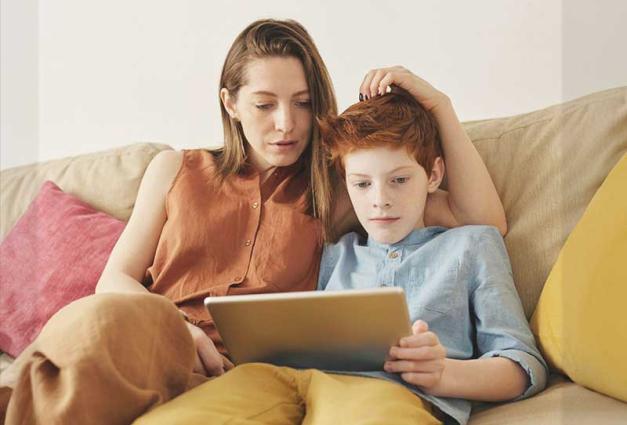Rethinking How to Make Your Workplace Environment Work for You
“Those plant moms on Instagram might be onto something.”
As with almost every aspect of our lives, the pandemic has changed the environments in which we work and live, and for many of us, it has even made those two environments one and the same. But one truth the pandemic hasn’t changed is that there are myriad ways we can optimize those environments so that they support our goals during the time that we spend in them.
Biophilic Design
As our team learned from a research study we conducted, bringing nature indoors is one way to achieve this. Interior biophilic design, or design that draws on our desire to connect with the natural world, can include the use of live plants, virtual natural imagery that captures our attention, and even sounds and smells that evoke a sense of being outdoors and immersed in spaces that have a relaxing effect.
But what is this relaxing effect, and how can we achieve it without necessarily needing to stroll through a forest in the middle of the day?
Although we’ve grown increasingly disconnected from our natural surroundings with the average American now spending 22 hours a day indoors (amounting to a whopping 93% of our lifespans!), our ancestors relied on the natural environment to survive. They foraged and hunted for food, often moving long distances to find optimal areas of land with ample resources and developed a deep connection with nature in the process.
That connection to nature has been transferred to us through our evolution, with our senses evolving through this movement and exploration and the continuous need to learn from our surroundings. Experiencing nature still provides us with a multitude of physical and psychological benefits.
So, how exactly might biophilic design help us address the disconnect between our evolutionary preferences and the indoor environments in which we now spend most of our lives?
Bring Nature Indoors
As our team sought to answer this question, we drew on studies showing that experiencing nature indoors can help lessen stress, restore our ability to focus, improve cognitive performance and satisfaction, and even improve mood during times of the day when we might otherwise be feeling irritable. When we experience what we perceive as nature, those evolutionary connections become activated, and so does our ability to behave in ways that support our goals.
To better understand which natural elements could be introduced to the spaces where people work, and their impact on how people think and feel, we recreated an open-office space at the Well Living Lab in Rochester, MN. We had the ability to change various aspects of that environment and were able to monitor how our participants, who worked full-time in this space, reacted to the changes.
We brought in a variety of easy-care indoor plants: some served as barriers to potentially distracting visual stimuli in participants’ field of view, while others were placed around the space and at different heights so they could be seen throughout the open office. We also included rotating natural imagery on monitors in the space that featured fractals, or patterns that we know to be pleasing to the human eye and potentially restorative. Finally, subtle live recordings of sounds in nature played via overhead speakers (think: wind blowing through the trees, intermittent chirping of birds , and gentle water streams).
After 10 weeks, the combination of these approaches did have a positive impact on the workers in the space. They were less stressed physiologically (measured with a wrist-worn device) when plants, digital greenery, and nature sounds were present in the space compared to when biophilic design elements were absent, and they also reported feeling more productive and more satisfied with the overall office environment. Even more notably, they demonstrated higher cognitive performance when exposed to biophilic visuals and audio than when no plants, images, or sounds were in the space.
You might be asking, “Ok, so what exactly does this mean for me?” Our response is this: it can mean a whole lot, or it can mean nothing at all—it’s entirely up to you to decide! We encourage you to make similar changes to your own environment and see how they make you feel. Add more plants or natural imagery to the area around your desk: do you find your attention drifting toward this greenery and wanting to pause to take it in? The benefits of that brief break from your work might surprise you. Instead of starting your morning with a news podcast, try substituting it for some hyper-realistic nature sounds in your headphones. Or better yet, if you’re fortunate enough to have access to an outdoor garden or greenery, take advantage of it! Your work, your mental health, and the people around you might end up thanking you for it.
For Further Reading
Aristizabal, S., Byun, K., Porter, P., Clements, N., Campanella, C., Li, L., Mullan, A., Ly, S., Senerat, A., Nenadic, I. Z., Browning, D. W., Loftness, V., & Bauer, B. (2021). Biophilic office design: Exploring the impact of a multisensory approach on human well-being. Journal of Environmental Psychology, 77, https://doi.org/10.1016/j.jenvp.2021.101682
Ratcliffe, E., Gatersleben, B., & Sowden, P. T. (2013). Bird sounds and their contributions to perceived attention restoration and stress recovery. Journal of Environmental Psychology, 36, 221-228. https://doi.org/10.1016/j.jenvp.2013.08.004
Kaplan, R., & Kaplan, S. (1989). The experience of nature: A psychological perspective. Cambridge University Press. https://books.google.com/books?id=7l80AAAAIAAJ
Paige Porter, a previous Well Living Lab research analyst, is the Communications and Program Manager for reDirect, an organization dedicated to helping nonprofits create more supportive environments and effective teams using a research-backed framework.
Sara Aristizabal is a research scientist at Delos Living and the Well Living Lab. Her research interests include the development of biometric indicators to assess health and wellness using wearable and non-invasive physiological sensors, the impact of biophilic design on human behavior, and the effect of the indoor built environment on human health.




